L.E. Carmichael's Blog, page 14
August 27, 2021
Jessica Vitalis: Death and Hope in The Wolf’s Curse
 Welcome to Cantastic Authorpalooza, featuring posts by and about great Canadian children’s book creators! Today’s guest:
Jessica Vitalis
. Take it away, Jessica!
Welcome to Cantastic Authorpalooza, featuring posts by and about great Canadian children’s book creators! Today’s guest:
Jessica Vitalis
. Take it away, Jessica!
I never meant to write about a story about death; not in the traditional “I’ve lost everybody I love” or the “I’m about to lose someone I really love” sense. After writing several dark and relatively painful manuscripts, I was ready for something new––something light. So when I saw a worn copy of Markus Zusak’s The Book Thief on my shelf and wondered what kind of middle grade story I would write with Death as the narrator, I figured I’d try to create something fun and possibly even humorous. I set out to write a plot-driven story about Death trying to trick a twelve-year-old kid into taking her job. And that’s exactly what I produced—a narrative about a kid who, for reasons I no longer remember, left home and, after a series of misfortunes, ended up on the receiving end of a job proposal from Death. I shared my manuscript with a trusted beta reader, who gave me feedback I wasn’t expecting: my story wasn’t about Death-the-character. It was (or needed to be) about actual death. (*cue dark, ominous music*)
My beta reader was right––what was the point of including Death in my story if I wasn’t going to write about grief and loss and all the things that give death power and meaning? But writing about grief and loss was something entirely different than writing what I’d expected to be a humorous adventure. I knew right away that if I was going to tackle the subject for middle grade readers, I had to do it honestly and without shielding them––I’m a big believer that books can and should be a safe place for children to experience life’s many struggles.
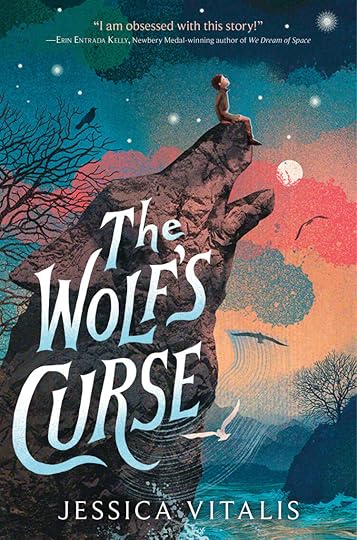 But there were already so many wonderful contemporary, realistic stories where children lose their loved ones––The Remarkable Journey of Coyote Sunrise, The Line Tender, and Glitter Gets Everywhere, to name a few––I wanted to do something different. Something that was both honest and fun. Something that still included Death-the-character. And so The Wolf’s Curse was born. Although the story opens with an actual death, it wasn’t until I finished writing a (brand new) first draft that I realized that my story isn’t about death at all––sure, a Death-like character is still the narrator and the story is filled with more than its fair share of grief. But kids don’t need an entire book about that––what they really need, and what I hope they’ll find on the pages of my book––is a story about friendship and resilience. A story about how to keep going when the odds are against you, when it doesn’t feel like there’s anything left worth fighting for. A story about finding family when yours has been taken away. A story that examines death with a realistic but snarky and sometimes even humorous lens––a story that will give readers the space to grapple with issues of mortality and loss while being immersed in a fantastical adventure. A story that will fill them with hope.
But there were already so many wonderful contemporary, realistic stories where children lose their loved ones––The Remarkable Journey of Coyote Sunrise, The Line Tender, and Glitter Gets Everywhere, to name a few––I wanted to do something different. Something that was both honest and fun. Something that still included Death-the-character. And so The Wolf’s Curse was born. Although the story opens with an actual death, it wasn’t until I finished writing a (brand new) first draft that I realized that my story isn’t about death at all––sure, a Death-like character is still the narrator and the story is filled with more than its fair share of grief. But kids don’t need an entire book about that––what they really need, and what I hope they’ll find on the pages of my book––is a story about friendship and resilience. A story about how to keep going when the odds are against you, when it doesn’t feel like there’s anything left worth fighting for. A story about finding family when yours has been taken away. A story that examines death with a realistic but snarky and sometimes even humorous lens––a story that will give readers the space to grapple with issues of mortality and loss while being immersed in a fantastical adventure. A story that will fill them with hope.
I may not have set out to write a book about death, but it turned out that I needed to do exactly that in order to write a story about all the things that are really important in life. As for writing something light––well, there’s always my next book (but don’t hold your breath).
To learn more about Jessica and her books, visit her website or follow her on social media:
August 20, 2021
Red Cedar Nomination and a New Presentation!
The Boreal Forest has been nominated for a Red Cedar Award!
Kermit GIF from Kermit GIFsThe Red Cedars are British Columbia’s children’s choice awards, and I am SO EXCITED to know that kids across British Columbia will be reading my book this school year! I decided to celebrate by designing a brand new presentation, one that combines cool STEM content and practical writing advice – two of my favourite things:
What’s Your Book About? How to Decide What to Leave Out
“What’s your book about?” is the second-most-common thing people ask a writer – just after “Where do you get your ideas?” But before we can tell other people, we have to be able to tell ourselves. Knowing what the book is really about lets us research efficiently, revise strategically, and avoid time-consuming tangents… producing a final draft that’s concise, cohesive, and effective.
In this presentation, I share the coolest animal facts that aren’t in The Boreal Forest, and explain exactly why I cut them. Then, we’ll walk through each draft of the book’s opening scene, exploring the step-by-step-decision-making process of rewriting. Throughout the program, two-minute challenges will give students a chance to apply these techniques to their own manuscripts.
All presentations will be virtual this year, for obvious reasons. And because I’m still up to my eyeballs in new writing projects, my availability is extremely limited. So teachers and librarians: If you’d like me to visit your class this year, please don’t wait!
July 23, 2021
It Turns Out I Am Bad at Vacation
 First things first: I am now fully vaxxed – woohooo! – and even though the second dose knocked me flat, I am intensely grateful for it, because next week I get to see my (also vaxxed) Dad and Not-So-Evil-Stepmother for the first time since October 2019.
First things first: I am now fully vaxxed – woohooo! – and even though the second dose knocked me flat, I am intensely grateful for it, because next week I get to see my (also vaxxed) Dad and Not-So-Evil-Stepmother for the first time since October 2019.
Go get your vaccines, people. Get your vaccines.
Second things second: it turns out I am really, really bad at vacation, because here’s how my “month off” actually went:
Week 1 – Line edits for my next children’s book (coming in 2023!)Week 2 – All the errands, administration, housework, and home improvement projects I’d been ignoring while fighting to make my spring deadlinesWeek 3 – All the errands, batch cooking for the freezer, and home improvement projects that needed to be out of the way so I’d be ready to go back to workWeek 4 – Turned a grant application into a book proposal and sent it off to my agent.Productivity is a disease, you guys, and I desperately need a vaccine for that, too.
Granted, this kind of thing is much less a problem when “vacation” means “travel.” But since “travel” still sounds pretty risky, and Sasquatch, my 19-year-old codependent cat wouldn’t survive without her fur parents anyway, we did a staycation. “Staycation,” as you probably know, means “answered slightly less email than normal.” Plus all of the aforementioned.
On the upside, I did plant some flowers, hang a bird feeder, and get my first haircut in 9 months. Which, if not entirely relaxing, is at least a step or two in that general direction…
What about you? Do you spend the first half of your vacations catching up and the second half getting ready to go back to “normal” life?
July 9, 2021
Carnival as a Protest and Theme in Nadia L. Hohn’s Malaika Books
Welcome to Cantastic Authorpalooza, featuring posts by and about great Canadian children’s book creators! Today’s guest: Nadia L. Hohn . Take it away, Nadia!
In my presentations, when I ask my young audiences to define a carnival, often, they talk about the rides, costumes and music. Carnival is also the celebration in which rich foods are eaten before the start of Lent, the forty days which precede Easter, observed by Christians worldwide.
For a child in the Caribbean diaspora, Carnival includes many of these things plus a parade and a multi day celebration. The most famous is the Trinidad Carnival, which had a huge influence in Malaika’s Costume as well as celebrations in parts of the Caribbean diasporas in the UK, Toronto, Brooklyn, and other cities.
In the Malaika series, Carnival is a pivotal part of each title in the series— Malaika’s Costume, Malaika’s Winter Carnival, and Malaika’s Surprise.
In Malaika’s Costume, it is the first Carnival time since Malaika’s Mummy migrated to Canada for work. When the money for her costume does not arrive, Malaika and her grandmother struggle to find a way that she can participate.
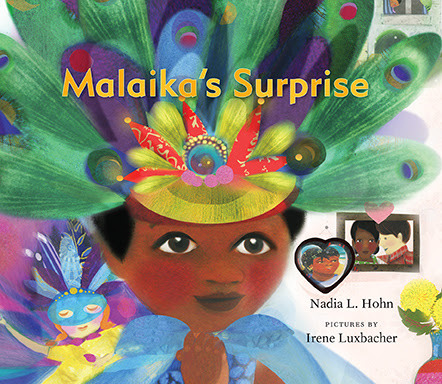 In Malaika’s Winter Carnival, Malaika joins her Mummy in Quebec City, Canada. Not only does she have to deal with a new family, language, and school. But, she needs to deal with a new Carnival, the Carnaval de Quebec to be exact. Instead of the colourful costumes, soca and calypso music Malaika is used to, this wintery carnival features ice sculpting and new customs.
In Malaika’s Winter Carnival, Malaika joins her Mummy in Quebec City, Canada. Not only does she have to deal with a new family, language, and school. But, she needs to deal with a new Carnival, the Carnaval de Quebec to be exact. Instead of the colourful costumes, soca and calypso music Malaika is used to, this wintery carnival features ice sculpting and new customs.
And in my newest installment, Malaika’s Surprise, Carnival becomes a means for Malaika to retain her cultural tradition and memories of her homeland as she adjusts to and embraces her life in Canada and her changing family.
Malaika’s Surprise begins with the main character and her stepsister Adele in colourful costumes playing a game they “call Carnival”. “Carnaval is here, Carnaval ici!” they sing, a reflection of their multilingual (Standard English, Caribbean Patois, French) and bicultural (Caribbean, French Canadian) household. Carnival sets the stage of the future surprises to come in this installment.
When I wrote Malaika’s Costume in 2010 as a class assignment in Ted Staunton’s Writing for Children class at George Brown College, I had no idea that it would evolve into what it is today. From a single book about the search for a Carnival costume to a story that begins at play in costumes for Carnival, this cultural practice became the thread that symbolizes Malaika’s character development and the struggle of every immigrant— retaining and blending elements of one’s culture (language, traditions, celebrations, days of significance, foods) in a foreign land.
My hope is that you enjoy this edition of Malaika’s story and the series will resonate with many for generations.
June 11, 2021
A Desperately Needed Vacation
So, how’s everyone doing out there?
Frustrated? Exhausted? Burnt out?
Yeah. Me too. I’ve been trying to figure out why I’m so tired – usually after I realize I’ve been staring into the middle distance for an unknown number of minutes while my brain was temporarily out of service. Then I realized that it’s been a really, really busy 18 months over here:
I launched The Boreal Forest. I planned two book tours – the original in-person version and the “Woah, I guess I have to learn how to livestream” version.I wrote the resource guide for the Million Tree Project.I wrote the first draft of a teacher’s guide for a super-cool palaeontology project. I wrote my first picture book – and got an agent!!I co-wrote a novel.I wrote three or four grant applications – I honestly don’t remember which.I developed a dozen new presentations, and gave them a whole lot of times.I filmed a whole lot of video.I attended two virtual conferences and took three virtual courses.That is… a ridiculously heavy workload for a year without a pandemic. Given the current state of the universe, it crosses over into the absurd.
I need a rest. I’m betting you do too. Let’s agree to spend a few weeks outside, sitting in the shade with a good book and a tall iced tea. We’ll meet back here in July. Or August. Could go either way. 
Take care of yourselves, everyone. And get your vaccines – if Fox Cousteau can do it, so can you.
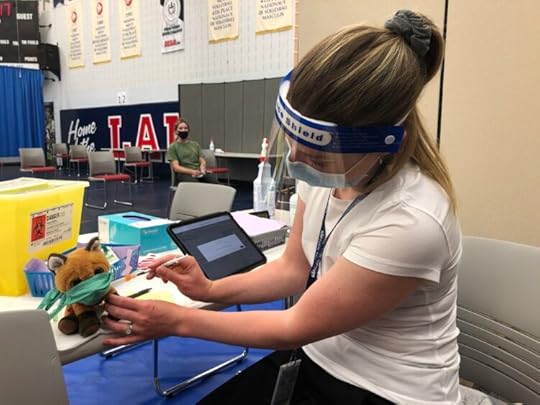
Thanks to Nurse Victoria for being such a great sport!
May 19, 2021
The Boreal Forest Wins A Yellow Cedar Honour
That’s it, really, the headline is the whole post. Except for maybe this:
Kermit GIF from Kermit GIFs
I am well and truly honoured by this news! The Forest of Reading is a children’s choice award program, and knowing that kids across the country thought my book was good enough to vote for? That’s both humbling and thrilling.
Be sure to check out the other honour book, Science Comics: Crows, and of course, the 2020 Yellow Cedar Winner, Trending. Both are excellent choices for summer reading!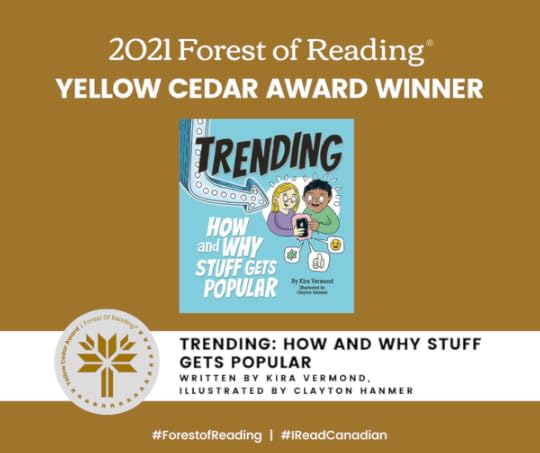
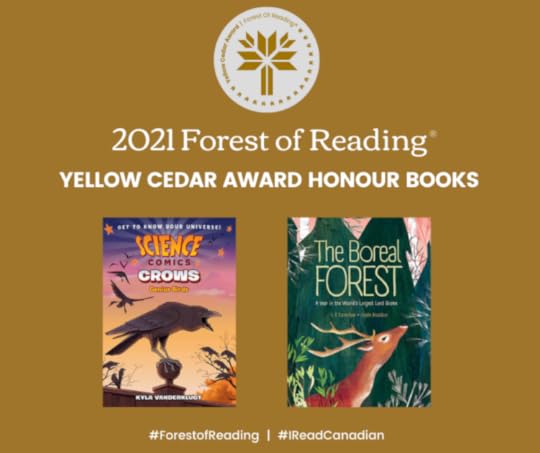
May 7, 2021
Erica Fyvie Goes Mad for Ads
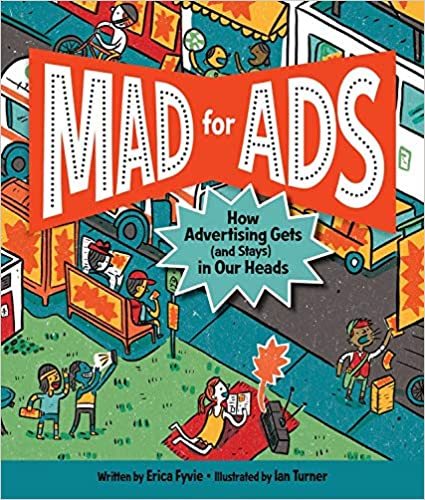 Welcome to Cantastic Authorpalooza, featuring posts by and about great Canadian children’s book creators! Today’s guest:
Erica Fyvie
. Take it away, Erica!
Welcome to Cantastic Authorpalooza, featuring posts by and about great Canadian children’s book creators! Today’s guest:
Erica Fyvie
. Take it away, Erica!
How did you get your initial idea for the book?
After I finished writing my first book, Trash Revolution, I found myself continuing to research the broken cycle of production-consumption-waste. It made me think about some of the reasons we become consumers, and why we support the companies we do. How did that brand get its hooks into me? If we look at our receipts, it can provide a pretty accurate picture of what’s important to us. Spending is personal, which makes the goals of advertising feel personal, too.
Who is Mad for Ads’ audience?
The age range is 10-12, and I had my 12-year-old self in mind while writing. That girl had a wall in her bedroom covered in ads—I would stare at it and imagine my future life. One particular aspect of advertising I write about is the power of repetition, and I wonder how many times I saw the same images and understood what a “successful” life would look like. I definitely got the memo about external cues for success, just as everyone else has. I hope that teachers enjoy the book and perhaps use it as part of media literacy discussions.
What is your advertising background?
I don’t work in advertising, but I think an outsider’s perspective can be helpful for shedding light on a topic. If you’re really interested in something and can offer a new approach, it might just work out! I did so much research into where Mad for Ads could fit among the existing books for kids. There are quite a few good books out there, but I wanted to try a different approach — I created fictional products and marketing campaigns in order to explain and tell the story.
Advertising is generally considered both pervasive and negative in society. How do you address that?
I wanted a look at advertising that didn’t deem it something just to fear or revile, but rather something that conveyed my genuine interest in how all of this works. Ads use fear (and virtually every other emotion) as such a powerful motivator—“buy this and you’ll prevent a future problem!”—that I didn’t want to fall into the same trap by just saying that the industry overall was something to fear. I’m more interested in how ads use fear-based techniques to tap into human behaviour.
How are personal brands connected to the industry of advertising?
It wasn’t until I began writing that I saw the link between powerful brands and the tools we use to develop our own personal brand. We inherently understand the way ad campaigns work because we launch new versions of ourselves over and over again. Now when I look at social media posts, I see the same tools I wrote about: associations, focal points, testimonials, claims, you name it. I hope the reader comes away hopeful, that we can use the same tools to expand our idea of representation, and that, if we’re lucky, we can expand our idea of what our own brand can look like, too.
April 30, 2021
Yellow Cedar Book Talks: An Earthling’s Guide to Outer Space
The Boreal Forest: A Year in the World’s Largest Land Biome, has been nominated for a Yellow Cedar Award in the 2021 Forest of Reading! I am both thrilled and honoured to be in such great company, so I’ve created a series of video book talks to celebrate the work of my fellow nonfiction kidlit authors and – hopefully – to inspire readers like you to discover their work.
Today, we’re discussing An Earthling’s Guide to Outer Space: Everything You Ever Wanted to Know About Black Holes, Dwarf Planets, Aliens and More, by Bob McDonald. Enjoy!
The Forest of Reading is a children’s choice award program that’s open to schools, libraries, and individual families. For more information on how to participate, visit the Registration page.
April 23, 2021
Managing Information: A Writer’s Workflow
 Welcome to Teach Write! This column draws on my 20 years’ experience teaching writing to kids, university students, and adult learners. It includes ideas and exercises that teachers and students can use in the classroom, and creative writers can use to level up their process.
Welcome to Teach Write! This column draws on my 20 years’ experience teaching writing to kids, university students, and adult learners. It includes ideas and exercises that teachers and students can use in the classroom, and creative writers can use to level up their process.
If you’ve been following the last three Teach Write columns on managing and organizing research, today is the day: the day we put it all together into a streamlined, efficient workflow.
Note that this the method I’ve arrived at over 20 years’ of trial and error. It’s what works best for me: it might not be what works best for you. Note as well that, as a professional writer-person, I am using next-level writer tools – Scrivener and Endnote – that might not be relevant for the writing you need to do. Note as well that you can swap out any reference manager for Endnote and get the same results.
A Writer’s WorkflowWith those caveats in place, this is how I go from notes to final draft without losing track of any of my sources:
Import or manually enter citation information into Endnote.Copy the Endnote field code.In Scrivener, create a file for that reference in my Research folder. Give it a unique name (typically Author/Year).Take notes into this file, pasting the Endnote field code at the end of every sentence or paragraph. Add page numbers to field codes as appropriate.Repeat for all the other references….Outline, draft, revise, revise, revise (more on those steps later)….Fact check the final draft. By fact check, I mean pull out ALL of my original sources and double check that the original text says what I think it does, and that every sentence of my draft is as accurate as it can possibly be.Format Endnote field codes as inline footnotes (see Scrivener help-files for how-to on this).Export my manuscript, including footnote codes, from Scrivener to Word.Using the Endnote plug-in within Word, convert Endnote field codes to properly formatted citations. Depending on what my editor wants, I might also strip the citations out of the text and simply generate a bibliography. Scrivener and Endnote make that option easy, too.Proof read and final format!A Note on Fact CheckingIf you’ve been following along for the last few Teach Write columns, your eyebrows might have lifted at #7. Why, you may be asking, if I’ve done such a great job of tracking my sources as I go, do I need to double check every sentence in the manuscript?
It’s because, no matter how hard I try or how careful I am, about 10% of my citations will be incorrect by the time I get to the final draft. There are several reasons for this:
I misunderstood something the first time I read my original referenceI made a typo in my notes – very common when dealing with numbers or statistics in STEM topicsDuring drafting or editing, sentence structure changed and a fact got separated from a citation.Doing this final check step reassures me that my research is sound and my words are accurate and that my work is the best it can possibly be… before any eagle-eyed readers get their hands on it!
I hope this series has been helpful. Stay tuned for future Teach Write columns as we delve into the final preparation step in writing: the dreaded outline.
Hey, did you know I teach writing workshops? It’s true – I work with adult writers, teachers, and students of all ages. Contact me to learn more.
April 16, 2021
Yellow Cedar Book Talks: One Earth: People of Color Protecting Our Planet
The Boreal Forest: A Year in the World’s Largest Land Biome, has been nominated for a Yellow Cedar Award in the 2021 Forest of Reading! I am both thrilled and honoured to be in such great company, so I’ve created a series of video book talks to celebrate the work of my fellow nonfiction kidlit authors and – hopefully – to inspire readers like you to discover their work.
Today, we’re discussing One Earth: People of Colour Protecting Our Planet, by Enjoy!
The Forest of Reading is a children’s choice award program that’s open to schools, libraries, and individual families. For more information on how to participate, visit the Registration page.



